Duo Zhang
MiMo: Unlocking the Reasoning Potential of Language Model -- From Pretraining to Posttraining
May 12, 2025Abstract:We present MiMo-7B, a large language model born for reasoning tasks, with optimization across both pre-training and post-training stages. During pre-training, we enhance the data preprocessing pipeline and employ a three-stage data mixing strategy to strengthen the base model's reasoning potential. MiMo-7B-Base is pre-trained on 25 trillion tokens, with additional Multi-Token Prediction objective for enhanced performance and accelerated inference speed. During post-training, we curate a dataset of 130K verifiable mathematics and programming problems for reinforcement learning, integrating a test-difficulty-driven code-reward scheme to alleviate sparse-reward issues and employing strategic data resampling to stabilize training. Extensive evaluations show that MiMo-7B-Base possesses exceptional reasoning potential, outperforming even much larger 32B models. The final RL-tuned model, MiMo-7B-RL, achieves superior performance on mathematics, code and general reasoning tasks, surpassing the performance of OpenAI o1-mini. The model checkpoints are available at https://github.com/xiaomimimo/MiMo.
Is AI Robust Enough for Scientific Research?
Dec 19, 2024



Abstract:We uncover a phenomenon largely overlooked by the scientific community utilizing AI: neural networks exhibit high susceptibility to minute perturbations, resulting in significant deviations in their outputs. Through an analysis of five diverse application areas -- weather forecasting, chemical energy and force calculations, fluid dynamics, quantum chromodynamics, and wireless communication -- we demonstrate that this vulnerability is a broad and general characteristic of AI systems. This revelation exposes a hidden risk in relying on neural networks for essential scientific computations, calling further studies on their reliability and security.
Asymptotically-Optimal Multi-Query Path Planning for Moving A Convex Polygon in 2D
Sep 05, 2024Abstract:The classical shortest-path roadmaps, also known as reduced visibility graphs, provide a multi-query method for quickly computing optimal paths in two-dimensional environments. Combined with Minkowski sum computations, shortest-path roadmaps can compute optimal paths for a translating robot in 2D. In this study, we explore the intuitive idea of stacking up a set of reduced visibility graphs at different orientations for a convex-shaped holonomic robot, to support the fast computation of near-optimal paths allowing simultaneous 2D translation and rotation. The resulting algorithm, rotation-stacked visibility graph (RVG), is shown to be resolution-complete and asymptotically optimal. RVG out-performs SOTA single-query sampling-based methods including BIT* and AIT* on both computation time and solution optimality fronts.
Toward Holistic Planning and Control Optimization for Dual-Arm Rearrangement
Apr 10, 2024Abstract:Long-horizon task and motion planning (TAMP) is notoriously difficult to solve, let alone optimally, due to the tight coupling between the interleaved (discrete) task and (continuous) motion planning phases, where each phase on its own is frequently an NP-hard or even PSPACE-hard computational challenge. In this study, we tackle the even more challenging goal of jointly optimizing task and motion plans for a real dual-arm system in which the two arms operate in close vicinity to solve highly constrained tabletop multi-object rearrangement problems. Toward that, we construct a tightly integrated planning and control optimization pipeline, Makespan-Optimized Dual-Arm Planner (MODAP) that combines novel sampling techniques for task planning with state-of-the-art trajectory optimization techniques. Compared to previous state-of-the-art, MODAP produces task and motion plans that better coordinate a dual-arm system, delivering significantly improved execution time improvements while simultaneously ensuring that the resulting time-parameterized trajectory conforms to specified acceleration and jerk limits.
A Multi-Scale Spatial Transformer U-Net for Simultaneously Automatic Reorientation and Segmentation of 3D Nuclear Cardiac Images
Oct 16, 2023Abstract:Accurate reorientation and segmentation of the left ventricular (LV) is essential for the quantitative analysis of myocardial perfusion imaging (MPI), in which one critical step is to reorient the reconstructed transaxial nuclear cardiac images into standard short-axis slices for subsequent image processing. Small-scale LV myocardium (LV-MY) region detection and the diverse cardiac structures of individual patients pose challenges to LV segmentation operation. To mitigate these issues, we propose an end-to-end model, named as multi-scale spatial transformer UNet (MS-ST-UNet), that involves the multi-scale spatial transformer network (MSSTN) and multi-scale UNet (MSUNet) modules to perform simultaneous reorientation and segmentation of LV region from nuclear cardiac images. The proposed method is trained and tested using two different nuclear cardiac image modalities: 13N-ammonia PET and 99mTc-sestamibi SPECT. We use a multi-scale strategy to generate and extract image features with different scales. Our experimental results demonstrate that the proposed method significantly improves the reorientation and segmentation performance. This joint learning framework promotes mutual enhancement between reorientation and segmentation tasks, leading to cutting edge performance and an efficient image processing workflow. The proposed end-to-end deep network has the potential to reduce the burden of manual delineation for cardiac images, thereby providing multimodal quantitative analysis assistance for physicists.
Deep learning-based flow disaggregation for hydropower plant management
Aug 11, 2023


Abstract:High temporal resolution data is a vital resource for hydropower plant management. Currently, only daily resolution data are available for most of Norwegian hydropower plant, however, to achieve more accurate management, sub-daily resolution data are often required. To deal with the wide absence of sub-daily data, time series disaggregation is a potential tool. In this study, we proposed a time series disaggregation model based on deep learning, the model is tested using flow data from a Norwegian flow station, to disaggregate the daily flow into hourly flow. Preliminary results show some promising aspects for the proposed model.
Dynamic Grouping for Climate Change Negotiation: Facilitating Cooperation and Balancing Interests through Effective Strategies
Jul 26, 2023Abstract:In this paper, we propose a dynamic grouping negotiation model for climate mitigation based on real-world business and political negotiation protocols. Within the AI4GCC competition framework, we develop a three-stage process: group formation and updates, intra-group negotiation, and inter-group negotiation. Our model promotes efficient and effective cooperation between various stakeholders to achieve global climate change objectives. By implementing a group-forming method and group updating strategy, we address the complexities and imbalances in multi-region climate negotiations. Intra-group negotiations ensure that all members contribute to mitigation efforts, while inter-group negotiations use the proposal-evaluation framework to set mitigation and savings rates. We demonstrate our negotiation model within the RICE-N framework, illustrating a promising approach for facilitating international cooperation on climate change mitigation.
Provably Robust Semi-Infinite Program Under Collision Constraints via Subdivision
Feb 02, 2023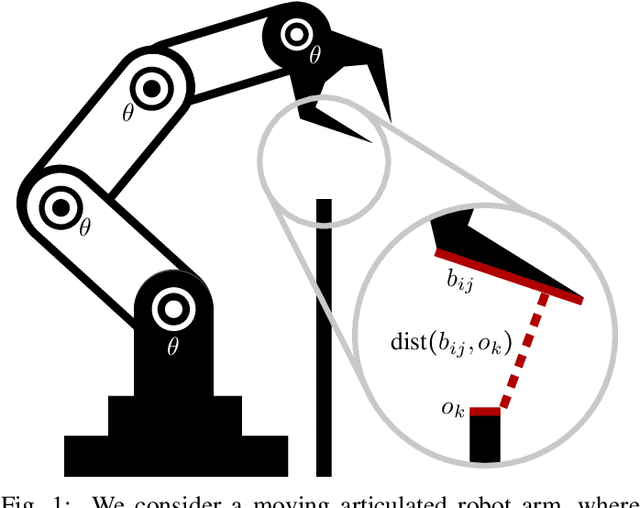
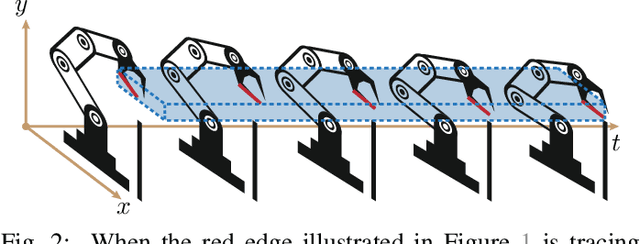

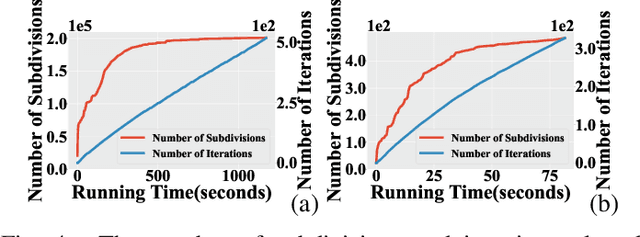
Abstract:We present a semi-infinite program (SIP) solver for trajectory optimizations of general articulated robots. These problems are more challenging than standard Nonlinear Program (NLP) by involving an infinite number of non-convex, collision constraints. Prior SIP solvers based on constraint sampling cannot guarantee the satisfaction of all constraints. Instead, our method uses a conservative bound on articulated body motions to ensure the solution feasibility throughout the optimization procedure. We further use subdivision to adaptively reduce the error in conservative motion estimation. Combined, we prove that our SIP solver guarantees feasibility while approaches the critical point of SIP problems up to arbitrary user-provided precision. We have verified our method on a row of trajectory optimization problems involving industrial robot arms and UAVs, where our method can generate collision-free, locally optimal trajectories within a couple minutes.
DPA-1: Pretraining of Attention-based Deep Potential Model for Molecular Simulation
Aug 20, 2022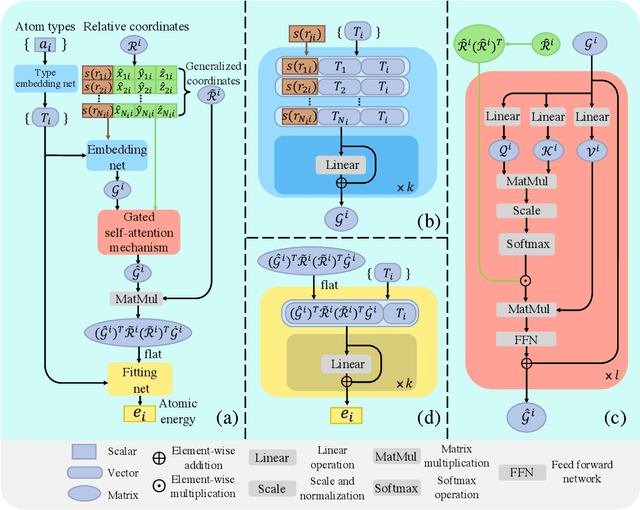
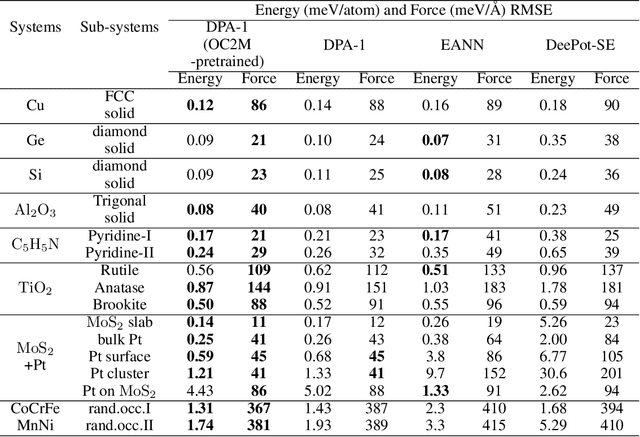
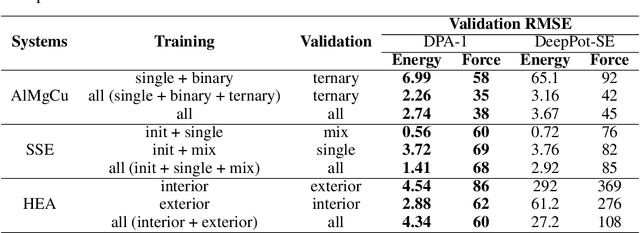
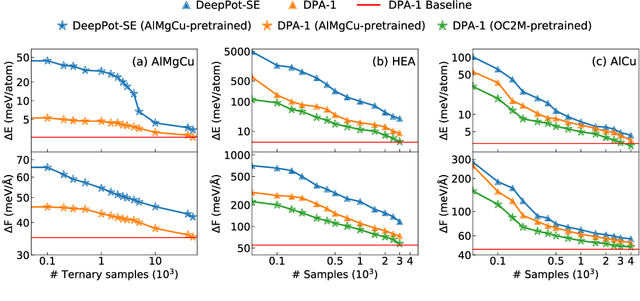
Abstract:Machine learning assisted modeling of the inter-atomic potential energy surface (PES) is revolutionizing the field of molecular simulation. With the accumulation of high-quality electronic structure data, a model that can be pretrained on all available data and finetuned on downstream tasks with a small additional effort would bring the field to a new stage. Here we propose DPA-1, a Deep Potential model with a novel attention mechanism, which is highly effective for representing the conformation and chemical spaces of atomic systems and learning the PES. We tested DPA-1 on a number of systems and observed superior performance compared with existing benchmarks. When pretrained on large-scale datasets containing 56 elements, DPA-1 can be successfully applied to various downstream tasks with a great improvement of sample efficiency. Surprisingly, for different elements, the learned type embedding parameters form a $spiral$ in the latent space and have a natural correspondence with their positions on the periodic table, showing interesting interpretability of the pretrained DPA-1 model.
Planning of Power Grasps Using Infinite Program Under Complementary Constraints
Jul 31, 2021



Abstract:We propose an optimization-based approach to plan power grasps. Central to our method is a reformulation of grasp planning as an infinite program under complementary constraints (IPCC), which allows contacts to happen between arbitrary pairs of points on the object and the robot gripper. We show that IPCC can be reduced to a conventional finite-dimensional nonlinear program (NLP) using a kernel-integral relaxation. Moreover, the values and Jacobian matrices of the kernel-integral can be evaluated efficiently using a modified Fast Multipole Method (FMM). We further guarantee that the planned grasps are collision-free using primal barrier penalties. We demonstrate the effectiveness, robustness, and efficiency of our grasp planner on a row of challenging 3D objects and high-DOF grippers, such as Barrett Hand and Shadow Hand, where our method achieves superior grasp qualities over competitors.
 Add to Chrome
Add to Chrome Add to Firefox
Add to Firefox Add to Edge
Add to Edge